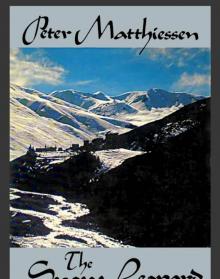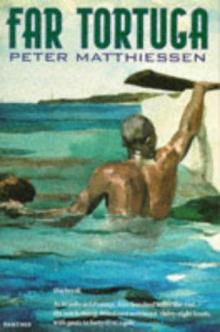- Home
- Peter Matthiessen
African Silences Page 7
African Silences Read online
Page 7
George Schaller’s The Year of the Gorilla remains the best book I know of on this area. When Schaller came here in 1959, the year before Zaire gained its independence, Goma was still a neat and charming Lake Kivu resort, a “European center” for Belgian colons and tourists alike; by the time he left, in late 1960, the civil strife that would devastate the country had begun. Today the weeds have taken over the walks and formal gardens. The open-air cafés are gone, the pleasant pastels of the storefronts are sadly faded, there is nothing in the stores, and nothing works; the telephone is chronically out of order, the water system is breaking down, and nobody is left who can fix either. To escape the place, we decided to visit the Virunga National Park.
As early as 1889 Léopold II had set up reserves to save the elephants from black people in order that they might be killed by whites. Additional reserves were created by Prince Albert in 1890, but the Virunga Park—the former Albert National Park, in what was then the Belgian Congo—was the first true national park in all of Africa; it was established in 1938 on the recommendation of Carl Akeley, who had collected five gorillas here a few years earlier for the American Museum of Natural History. Since then the park has been considerably enlarged, before and after the independence of Zaire in 1960.
When I first came to Africa, in the early winter of 1961, it was assumed that the Albert Park and all its animals were being ravaged and destroyed by the hordes of insensate Africans who were making life so miserable for the colonials; but this report turned out to be as exaggerated as many others, and much credit should be given to the park’s African guards, who went unpaid for several years and defended what is now Virunga against the worst of the depredations. At the park entrance there is a plaque commemorating the brave twenty-three who “died for the elephants” in those dark years. Jacques Verschuren, who wrote a moving book about these men, is the former director of the Institut National pour la Conservation de la Nature (INCN), which administers Zaire’s seven national parks; these include vast forest tracts in the interior as well as the group of beautiful reserves among lakes and mountains of the Rift. Because of a strong park tradition as well as a small human population, all seven parks continue to do well.
On Saturday morning we arranged a ride to Nyiragongo, the southernmost of the Virunga volcanoes, which rise to the south of Ruwenzori or “Mountains of the Moon,” just below the equator between East Africa and northern Zaire. Several of the “fire mountains” are still active, and only a year before, on January 10, 1977, Nyiragongo quite suddenly erupted. As five coulees, or lava rivers, poured down its steep sides, the entire Bahutu village of Bukuma utterly vanished and more than two hundred people died. Destroying the prison and many other buildings, the flow reached the northern outskirts of the town of Goma in just twenty-seven minutes, rolling within a half mile of the airport, with its large depot of fuel; had the lava touched that depot, it is said, half of Goma would have been destroyed. The northward road into the Virungas vanished, and not for a month did the lava cool sufficiently to carve out the new road; a pretty graveyard in a grove of tall mimosas not far east of the road was one of the few locations that was spared. A few scorched skeletons of trees still stand in the shining fields, and these are being chopped for fuel by survivors of the cataclysm, who straighten here and there, in silhouette, to watch us pass.
Climbing the hill, we look across to dense plantations in Rwanda. This region of volcanic ash forms a rich and well-drained soil—one of the few good soils in all of Africa—and Kivu Province, despite civil wars and economic setbacks, continues to produce good crops of tea and coffee, bananas, cinchona, and pyrethrum. There is no smoke from the volcanoes, and on islets of high ground new gardens and banana groves have been established, but one day in the not far distant future, Nyiragongo—the mother of the spirit Gongo—will erupt again.
Augustus Gabula, the young Bahutu warden who guided us uphill on Nyiragongo, was near the summit when the 1977 eruption took place; his family in their village on these lower slopes had four minutes to flee before their hut was destroyed. Augustus himself ran down through a tongue of forest between lava rivers, his path broken by an elephant herd that was stampeding off the mountain. Perhaps because, as mammalogist Jean Dorst informs us, “Having the legs straight with the bones placed vertically one above another, they are quite incapable of leaping,” not all of Nyiragongo’s elephants survived. Augustus led us two or three miles up the main flow to a place where a group of six beasts had been overwhelmed; probably they were asphyxiated as this outpouring of lava burned up the oxygen across the mountainside. Among the hollows in the lava field are scattered a group of amorphous molds left by burnt hardwood trees and large white bones. A few liverworts and Osmunda ferns now prosper in these crannies. In one of the graves the whole form of the elephant is still discernible, even the holes made by its tusks (long since removed) and a sad, curved tube of stone where the trunk lay. These were forest elephants (once considered a distinct species), and some of them were young. Although there is no forage near the graves, only marigold, coarse bracken, and shrubby acanthus with pale lavender thorned flowers, a number of elephants have made their way out onto the cooled lava and communed for a time with the six encased in stone, to judge from the copious amount of dung around the gravesites.
Toward noon, clouds shift and rain comes blowing through the forest, leaving behind a hot and humid sun. The Kivu-Ruwenzori chain is the heart of the African highland-forest habitat, which has outposts in Ethiopia, in the Kenya highlands, and on Mount Meru and Mount Kilimanjaro in northern Tanzania, as well as far westward on Mount Cameroon. All of these places share many species of flora and fauna. At the lava’s edge broad carpets of large pale yellow composites mark the transition zone, and within the forest the tree limbs are thickened by moist gardens, mostly fern and orchid. The flowers I recognize are pink Impatiens, peas, the gloriosa lily, and a large hibiscus with blossoms of a dark, sinister lavender. Strangely, butterflies are few, and other than elephant trails, with their fresh dung, there is little sign of animals. But a small troop of the beautiful L’Hoest’s monkey barks at our appearance, then retreats with dignity across a tongue of lava; these semiterrestrial cercopithecines are shining black with a bright chestnut oval patch from the shoulders to the base of the long tail and with a striking mass of fluffy white whiskers, and one has an infant clasped to her belly. Compared with its relatives, the mona and blue monkeys, which are widespread in West and East Africa, respectively, the L’Hoest’s monkey has an odd, small, scattered range, being confined to the mountains of eastern Zaire, Mount Cameroon, and the island of Fernando Poo, in the Gulf of Guinea.
Since most of my African travels have been made in the thorn scrub and savanna of the plains, I am not familiar with the highland avifauna and am happy to have Forbes-Watson as a guide. Alec has seen more species of African birds than anyone alive (not his own claim—I have heard it made for him by others), and on Nyiragongo we identify some forty species, more than half of which are new to me. Sarah Plimpton is delighted by the courtship displays of puffbacks and sunbirds, the wistful notes of flycatcher and cuckoo, the flocks of olive pigeons, high and dark, passing overhead. A strange, sad, single note is made by Lagden’s bush shrike, which has the striking golden-yellow breast and belly of its East African relatives; we also take note of a regal sunbird—a sunlit male on a bare limb—a red-faced woodland warbler (not red-faced at all; it looks as if it had dipped its face into a peach), and a white-tailed blue flycatcher, flaring the white outer feathers of its tail to catch up sun. For Forbes-Watson these four species are “life birds,” as they are known to the bird fraternity, the first of their species he has ever seen, and Sarah and I feel privileged to see them with him; the last time Alec had as many as three life birds in a single day was years ago, on his first visit to Mount Cameroon.
Forbes-Watson is an East African colonial raised up in the “White Highlands,” a veteran of the Kenya Regiment in the Mau Mau days, and a former game warden who likes other wardens and white hunters and is liked by them, yet is amused by the “old boy” element that takes its own romantic mystique so very seriously. I first met him in Nairobi eight or nine years ago, and though we haven’t known each other well, we have many friends in common and find that we agree about almost all of them. “I grew up with these chaps, you see,” Alec says gently, “and some of them are still trying to pretend that East Africa is like it was, and it just isn’t.” (Unlike many white East Africans, Alec speaks fluent ki-Swahili, not just the up-country kind used on safari; since he does not cling to the colonial mentality, he truly enjoys talking to Africans and feels quite at home in eastern Zaire, where Swahili is in common use.)
On Sunday, when we rise at 5:30 A.M. to take the steamer from Goma to Bukavu, people are descending toward the lake with all sorts of buckets and containers; apparently the waterworks is out completely. A little boy toting water back uphill has been toppled by a jerry can that is much too big for him, and two small friends try to lift it back upon his head as he totters in a circle on the road edge. Beyond the cove where the water is being taken, more crowds are streaming alongshore toward the ferry. Many are passengers—one woman bears a very large, bright yellow suitcase balanced on her head—but most of these must be mere well-wishers. Or so we hope, since the old boat has no seats at all and in any case will be loaded up like an aquatic bush taxi with as many citoyens as can be crammed aboard.
Lake Kivu, at nearly five thousand feet, is the highest of the central lakes that fill the depressions in the mighty rift that splits the continent, and its ice-clear, dark blue waters, set about by high mountains of Zaire and Rwanda, make it one of the loveliest places in all Africa. The Zairois claim that it is Africa’s highest lake (Kenya’s Lake Naivasha and Lake Nakuru are both higher) and that, due to the great amount of methane gas derived from rotting vegetation on the lake bottom, its waters are poisonous and without life. But this morning we saw that these waters may be used by humans if need be, and some small tilapia at the dock pilings explain the activities of an African cormorant, seen diving yesterday some distance off the shore. However, these fish are not large enough to sustain any real fishery; the few pirogues seen on the lake are mostly transporting bananas and other produce from outlying islands and villages to Goma.
Soon the Etoile is passing close to the west shore of Idjwi Island, a forested ridge, sparsely inhabited, that dominates the center of the lake, and toward midmorning a brief stop is made to drop off something at a mission village. In a cove, under banana fronds, boys are fishing for the small tilapia with wispy poles, and other boys dart forward in pirogues to offer golden pineapples to the passengers. Jokes, coins, and pineapples fly back and forth across the rails, and in less than a minute the Etoile is under way again along Idjwi’s western shore, it high wake threatening the numerous pirogues that harvest the island plantations; the boatmen wave at us in fear and grandly we wave back.
On Lake Kivu the pirogue looks crude, and its paddle is carved like a deep scoop that cups the water; the paddling motion is a wild overhand that throws arcs of water forward across the shoulders—an inefficient paddle and a poor technique, or so it appears, suggesting the absence of a real fishery tradition. (Most African paddles have the graceful shapes of hearts or blades, as in the great basin of the Amazon, and across the centuries the long pirogues of both Congo and Amazon, sharp-pointed at both ends, have arrived at a near-identical, clean, pure design). Yet the Kivu pirogues carry immense loads of bananas across wide stretches of open water that are often roiled by squall and wind; sometimes one can scarcely see the paddlers, three of whom may be squashed into the stern.
Beyond Idjwi the Etoile returns to the mainland shore, among myriad small, pretty channel islands. Two gray-headed gulls, a distant stork, a white egret point up the surrounding emptiness of sky and mountain; to the southwest rise Mount Kahuzi and Mount Biega. Then the Etoile rounds the southernmost of five peninsulas (“a hand of verdure dipped in the lake,” the guidebook says) and docks in the tranquil harbor of Bukavu.
Across the cove lies a collection of odd boats, retired for reasons of old age or want of fuel. The largest and most ancient craft, a wonderful old steamboat of the early century, is the retired lake ferry of colonial days, Le General Tombeur, now renamed Lt. Col. Potopoto. Lieutenant Colonel Potopoto—whose name, in the local Lingala tongue, means “mud”—was one of the many heroes of the recent revolution, and his lettered name is the only new paint on this faded ship. Under the name Lt. Col. Potopoto the ferry has never left the dock.
The red roofs of Bukavu on its five peninsulas are strikingly inset in green plantations of tea and coffee, cinchona and pyrethrum, broken by forest stands of gum and pine on hills that rise perhaps fifteen hundred feet above the lake. Like Goma, the town lies on the border with Rwanda, which furnishes eastern Zaire with goods no longer available in this country. In Zaire fuel at the official price is not available, and even the government bureaus here must sometimes depend on black-market gasoline, which during one week in early April of 1978 rose from twenty-five to thirty dollars per gallon. At that price one might well wonder if gasoline or smuggled ivory or other contraband lies beneath those cargoes of bananas that are plied back and forth across the lake.
For want of gas no taxis have come down to meet the boat. Consigning our gear to three young boys, we walk slowly up into the town. The colorful broad boulevards of flowering cassia and coral trees are strangely empty, and so are the shops that, at the time of Schaller’s visit in 1959, carried “the latest imports from Brussels, Paris, and Copenhagen.” The paint has faded, all the street cobbling is coming up; there are no tourists and few cars. The shortage of gas has saved the life of a driver of a truck that lost its brakes on the incline of this street and rolled downhill backward, overrunning the gas pumps in the station. The garage roof now pins the truck in place; had those pumps been full, not only the truck but the Hotel Residence itself would be no more.
In other days this hotel was known as the Residence Royale, and though the statuary has been removed from niches in the marble stairwells, one may still contemplate the grandeur of days past in some old stuffed heads, huge portraits of the great buildings of Belgium, an antique elevator that can only be stopped by hurling the door open at the right floor, a dining salon in rococo plush, and other appointments of more spacious times. In our efforts to economize we take rooms in the quatrième catégorie, but even these have their own vast bathrooms and a lake vista or at least a prospect of the boulevard, as well as a view of the Pêle-Mêle Garage across the street.
Having got to Bukavu, we must now work out a way to cross the mountains of the rift and descend into the jungle haunts of the Congo peacock. According to Forbes-Watson the nearest village to the place where Chapin saw the peafowl is called Utu, which lies not far from Walikale, about a hundred miles to the northwest, along the jungle road to Kisangani (the former Stanleyville). This road descends from the Kahuzi-Biega Mountains, where we hope to make camp long enough to get a good look at gorillas. But since it costs twenty-five dollars simply to go out to the airstrip, we could scarcely consider hiring a car even if someone could be found to take us. Planes or supply trucks that serviced Christian missions at Walikale or the tin-mine station in the region, at Obaye, seemed our best hope, for only a large corporation or a mission could put together enough fuel for such a journey.
A Catholic mission has a station out at Walikale, and we sought to befriend the monseigneur at the cathedral, which is located high on the hill above Bukavu, surrounded by candelabra cypress and the remains of flower gardens, turned over now to manioc and maize. The monseigneur (an African) assured us that the Walikale mission was not under his jurisdiction and that anyway, only the Protestants had planes. We sought out a Mr. and Mrs. Fred Bahler of the Grace Mission, who proved hospitable, serving us coffee and cookies in their house above the lake and contacting the mission pilot on our behalf, but the pilot was already overbooked and could not help us. The Bahlers thought that we should see Adrien Deschryver, a former professional hunter who flew a plane for the national parks that might be chartered; and they repeated a story we had heard in Goma. A few years ago an American woman, Lee Lyon, had seen the Congo peacock in the wild and taken pictures of it, not at Utu but at Uku, which means “over there.” Ms. Lyon had been killed a few years earlier by a young elephant while photographing an elephant-capture program in Rwanda, but Deschryver had been with her at Uku and could give us all the details of the story. Apparently Deschryver was away, but since he lived on the same road as the Bahlers, they would be happy to leave our message at his house.
Subsequently we talked to Citoyen Muzu, head of the local government bureau of mines, who sat with a number of unemployed friends in a huge office of the colonial period, under a high ceiling with big holes in it; like so many bureaucratic offices in the new Africa, this one makes plain that the real business is transacted elsewhere. Earlier Muzu had told us that he not only knew the Walikale area but had seen the famous paon de Congo; now he seemed less sure that this was true. By not repeating it, Muzu withdrew an earlier suggestion that he escort us in person to the peacock. No, he said, we must go to the Société Minérale de Kivu (Sominki), which actually ran the mines down in the jungle.
Partly because of Sarah’s wide-eyed charm, the Belgian mine agents were very helpful; there was a truck that went down to the jungle every week, and we were welcome to ride upon it, on the condition that we would provide for ourselves and be ready to depart at the driver’s convenience. But today was Monday, and the truck would not leave until later in the week, and time was running out; my visit to the jungle now depended, in effect, upon Adrien Deschryver, and no one knew when Deschryver would return.

 Lost Man's River: Shadow Country Trilogy
Lost Man's River: Shadow Country Trilogy The Tree Where Man Was Born
The Tree Where Man Was Born The Snow leopard
The Snow leopard Sand Rivers
Sand Rivers The Cloud Forest
The Cloud Forest Sal Si Puedes (Escape if You Can)
Sal Si Puedes (Escape if You Can) Far Tortuga
Far Tortuga Men's Lives
Men's Lives On the River Styx: And Other Stories
On the River Styx: And Other Stories Shadow Country
Shadow Country At Play in the Fields of the Lord
At Play in the Fields of the Lord Lost Man's River
Lost Man's River Killing Mister Watson
Killing Mister Watson On the River Styx
On the River Styx